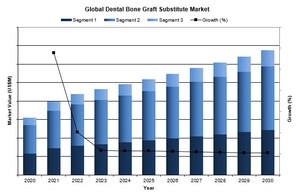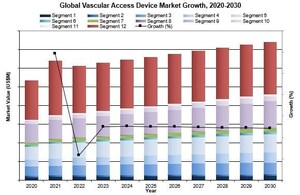VANCOUVER, BC, Oct. 17, 2024 /PRNewswire/ - The global laparoscopic device market is set for sustained growth driven by increasing procedural volumes, technological advancements, and a shift towards minimally invasive surgical techniques. Key components of this market include laparoscopes, trocars, hand instruments, insufflators, and suction-irrigation pumps. These devices enable visualization and access for various abdominal and pelvic surgeries, contributing to the efficiency of laparoscopic procedures worldwide.
The market's growth is primarily fueled by the demand for disposable laparoscopic instruments, sustained by the high procedural volume. Closure devices represent the largest segment, accounting for 40% of the global market value, underscoring the importance of these devices in minimally invasive surgeries.
Rising Demand for Laparoscopic Treatments Driven by Prevalence of Cancer and Gastrointestinal Disorders
Laparoscopic devices are integral in treating a variety of conditions, including gynecologic cancers, colorectal issues, and gastrointestinal disorders, with prevalence rates varying significantly across regions. In the U.S., gynecologic cancers are a major concern, with approximately 94,000 diagnoses and nearly 28,000 deaths annually. Uterine cancer remains the fourth most common cancer among women in the U.K., while ovarian cancer presents a substantial burden, with an estimated 19,880 new cases and 12,810 deaths in the U.S. in 2022 alone. Colorectal cancer is another major area of concern, ranking as the third most commonly diagnosed cancer worldwide, with higher incidence rates observed in Western Europe and East Asia. Hernia repairs, particularly for inguinal hernias, are common procedures in the U.S., where around one million abdominal wall hernia surgeries are performed each year. Additionally, diverticulitis and Crohn's disease are prevalent, especially in Western nations, where advanced diagnostic techniques and prompt treatment contribute to higher reported incidence rates. The need for laparoscopic interventions continues to grow globally as minimally invasive approaches become the standard for managing these widespread conditions.
Regional Trends
North America, Asia-Pacific, and Western Europe collectively dominate the global laparoscopic device market due to higher unit sales, device costs, and favorable demographic trends. These regions are projected to maintain their leadership positions throughout the forecast period.
The global market is expected to experience a steady single-digit growth rate, driven by demographic shifts and the ongoing adoption of minimally invasive techniques. While laparoscopy is evolving toward robotic-assisted surgery, the development and adoption of new technologies may be tempered by current hospital priorities, such as infection prevention and managing elective surgery backlogs from the pandemic.
The laparoscopic device market is expanding beyond North America and Europe, with significant growth in Latin America and Asia-Pacific. In Latin America, countries like Brazil, Mexico, and Argentina are seeing increased laparoscopic surgeries due to rising disease burdens and healthcare improvements. Meanwhile, in Asia-Pacific, including China, India, and Japan, demand is driven by an aging population, lifestyle changes, and investments in healthcare. As laparoscopy becomes the standard for many surgeries in these regions, the market is set for strong growth, creating opportunities for manufacturers and fueling global expansion.
Increasing Adoption of Laparoscopy in Diverse Procedures
Laparoscopic techniques continue to replace traditional open surgery, particularly in Europe, where the number of laparoscopic procedures is steadily increasing. Laparoscopy's advantages, including reduced recovery time and shorter hospital stays, are driving the adoption of these techniques, even enabling many procedures to be performed in outpatient settings. However, outpatient care remains less developed in Europe compared to the U.S.
The U.S. market has also seen consistent growth in laparoscopic procedures, particularly in hernia repair, nephrectomy, colectomy, and sleeve gastrectomy. Cholecystectomy was the most common laparoscopic procedure performed in 2022. The ongoing introduction of innovative devices is expected to further enhance the efficiency and clinical outcomes of these procedures. However, the rise of robotic-assisted surgery poses a limiting factor on the growth of standard laparoscopic device segments.
Competing Technologies in Minimally Invasive Surgery
In Europe, the ultrasonic laparoscopic device market has grown rapidly, challenging the dominance of direct energy devices. The rise in minimally invasive surgery has fueled demand for ultrasonic devices, which offer precise tissue dissection, minimal damage to surrounding tissues, and shorter operating times. Technological advancements like tissue recognition and vessel sealing have improved safety and efficiency, while reduced smoke and odor compared to electrosurgical tools enhance the surgical environment.
In the U.S., the laparoscopic direct energy device market remains strong, driven by innovation and increased use of minimally invasive techniques. Despite ongoing development in precision and specialized devices, challenges such as high costs and training requirements persist, along with concerns over risks like thermal injury. Both markets show growth, with Europe's ultrasonic devices gaining traction as a competitive alternative, while direct energy devices maintain a dominant position in the U.S.
Market Leaders: Medtronic, Ethicon, and Karl Storz
Medtronic emerged as the leading competitor in the global laparoscopic device market in 2023, driven by its LigaSure™ vessel sealing system and Endo GIA™ stapling products. The company's innovation, such as Tri-Staple™ technology and SILS™ single-port instruments, bolstered its strong market presence.
Ethicon followed closely behind, with significant market share in closure devices and ultrasonic energy products, notably the HARMONIC® line. Its diverse trocar portfolio and leadership in ultrasonic device technology position it as a major player in the market.
Karl Storz ranked third, capitalizing on its expertise in reusable hand instruments and laparoscopes. The company's dominance in the hand instrument market, coupled with its well-established HOPKINS® rod lens laparoscopes and Endoflator® insufflators, contributed to its success.
Other competitors within this market include Olympus, Stryker, Applied Medical, CONMED, Richard Wolf, Becton Dickinson, B. Braun, ERBE, Allurion, LiNA Medical, Microline Surgical, BOWA Medical, and more.
Outlook
The global laparoscopic device market is expected to benefit from the ongoing transition to minimally invasive surgical techniques and the introduction of innovative products that enhance procedural efficiency. While robotic-assisted surgery may limit growth in some segments, the overall demand for laparoscopic devices will remain strong due to increasing procedural volumes and evolving surgical standards.
For more information on the laparoscopic device market, please visit one of the following links depending on your geographic interest:
Global Laparoscopic Devices Market - 2024-2030
U.S. Laparoscopic Devices Market - 2023-2029
European Laparoscopic Devices Market - 2023-2029
SOURCE iData Research Inc.

WANT YOUR COMPANY'S NEWS FEATURED ON PRNEWSWIRE.COM?
Newsrooms &
Influencers
Digital Media
Outlets
Journalists
Opted In





Share this article